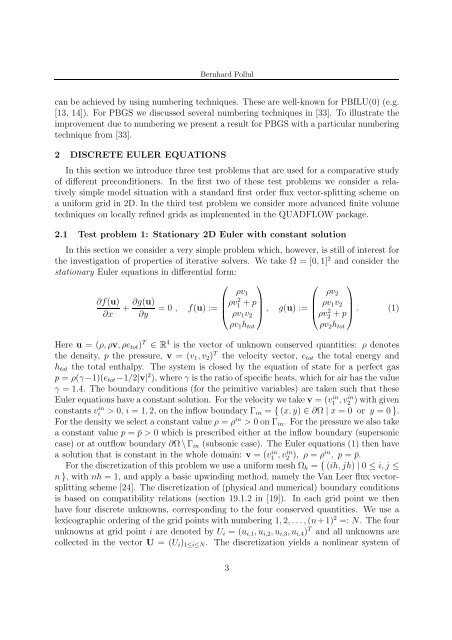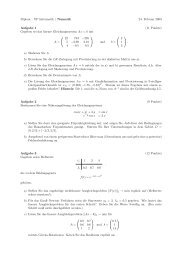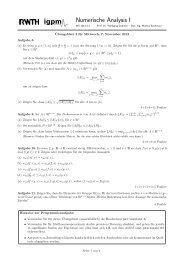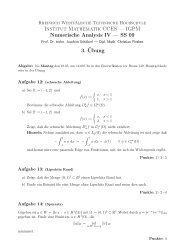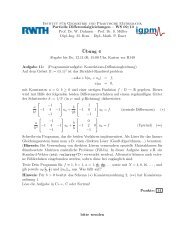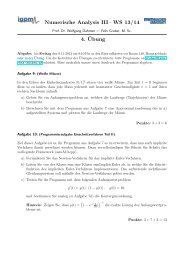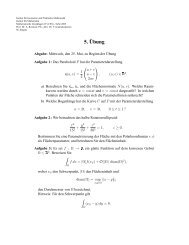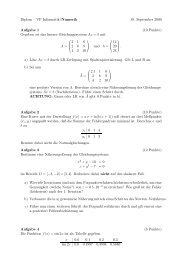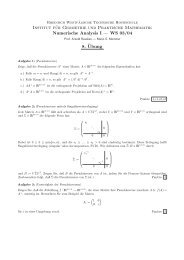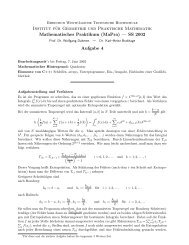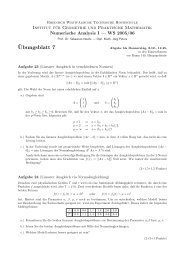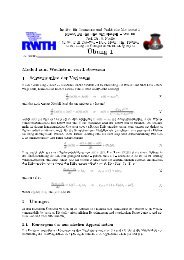preconditioners for linearized discrete compressible euler equations
preconditioners for linearized discrete compressible euler equations
preconditioners for linearized discrete compressible euler equations
Create successful ePaper yourself
Turn your PDF publications into a flip-book with our unique Google optimized e-Paper software.
Bernhard Pollul<br />
can be achieved by using numbering techniques. These are well-known <strong>for</strong> PBILU(0) (e.g.<br />
[13, 14]). For PBGS we discussed several numbering techniques in [33]. To illustrate the<br />
improvement due to numbering we present a result <strong>for</strong> PBGS with a particular numbering<br />
technique from [33].<br />
2 DISCRETE EULER EQUATIONS<br />
In this section we introduce three test problems that are used <strong>for</strong> a comparative study<br />
of different <strong>preconditioners</strong>. In the first two of these test problems we consider a relatively<br />
simple model situation with a standard first order flux vector-splitting scheme on<br />
a uni<strong>for</strong>m grid in 2D. In the third test problem we consider more advanced finite volume<br />
techniques on locally refined grids as implemented in the QUADFLOW package.<br />
2.1 Test problem 1: Stationary 2D Euler with constant solution<br />
In this section we consider a very simple problem which, however, is still of interest <strong>for</strong><br />
the investigation of properties of iterative solvers. We take Ω = [0, 1] 2 and consider the<br />
stationary Euler <strong>equations</strong> in differential <strong>for</strong>m:<br />
⎛<br />
∂f(u)<br />
∂x<br />
+ ∂g(u)<br />
∂y<br />
⎞<br />
ρv 1<br />
= 0 , f(u) := ⎜ρv1 2 + p<br />
⎟<br />
⎝ ρv 1 v 2<br />
⎠ ,<br />
ρv 1 h tot<br />
⎛ ⎞<br />
ρv 2<br />
g(u) := ⎜ ρv 1 v 2<br />
⎝ρv 2 2 + p<br />
⎟<br />
⎠ . (1)<br />
ρv 2 h tot<br />
Here u = (ρ, ρv, ρe tot ) T ∈ R 4 is the vector of unknown conserved quantities: ρ denotes<br />
the density, p the pressure, v = (v 1 , v 2 ) T the velocity vector, e tot the total energy and<br />
h tot the total enthalpy. The system is closed by the equation of state <strong>for</strong> a perfect gas<br />
p = ρ(γ−1)(e tot −1/2|v| 2 ), where γ is the ratio of specific heats, which <strong>for</strong> air has the value<br />
γ = 1.4. The boundary conditions (<strong>for</strong> the primitive variables) are taken such that these<br />
Euler <strong>equations</strong> have a constant solution. For the velocity we take v = (v in ) with given<br />
1 , vin 2<br />
constants vi in > 0, i = 1, 2, on the inflow boundary Γ in = { (x, y) ∈ ∂Ω | x = 0 or y = 0 }.<br />
For the density we select a constant value ρ = ρ in > 0 on Γ in . For the pressure we also take<br />
a constant value p = ¯p > 0 which is prescribed either at the inflow boundary (supersonic<br />
case) or at outflow boundary ∂Ω \Γ in (subsonic case). The Euler <strong>equations</strong> (1) then have<br />
a solution that is constant in the whole domain: v = (v1 in,<br />
vin 2 ), ρ = ρin , p = ¯p.<br />
For the discretization of this problem we use a uni<strong>for</strong>m mesh Ω h = { (ih, jh) | 0 ≤ i, j ≤<br />
n }, with nh = 1, and apply a basic upwinding method, namely the Van Leer flux vectorsplitting<br />
scheme [24]. The discretization of (physical and numerical) boundary conditions<br />
is based on compatibility relations (section 19.1.2 in [19]). In each grid point we then<br />
have four <strong>discrete</strong> unknowns, corresponding to the four conserved quantities. We use a<br />
lexicographic ordering of the grid points with numbering 1, 2, . . ., (n+1) 2 =: N. The four<br />
unknowns at grid point i are denoted by U i = (u i,1 , u i,2 , u i,3 , u i,4 ) T and all unknowns are<br />
collected in the vector U = (U i ) 1≤i≤N . The discretization yields a nonlinear system of<br />
3


